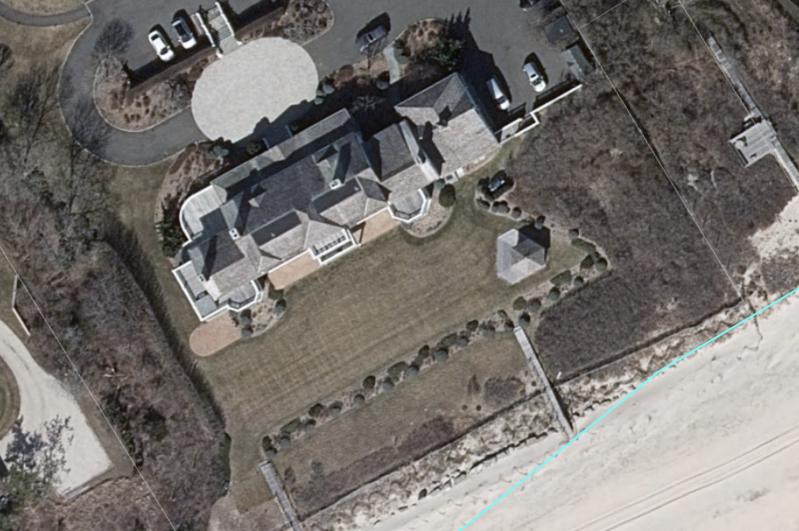Gail Golden Icahn said the yellowjackets were just too much.
“At some point we had a yellowjacket-swarming for a number of seasons,” she told the East Hampton Village Zoning Board of Appeals on July 8. “You could not sit outside. The bees were everywhere.”
The Icahns solved the problem by putting up a collapsible gazebo, “one of those things you can buy on Wayfair,” Ms. Icahn told the board. Their property on Nichols Lane, identified on the application as Hamptons Residence L.L.C., includes 290 feet of ocean frontage, and the gazebo allows them to enjoy the view while eating breakfast, she said.
The problem was that the gazebo would get knocked over in high winds. Over time, they replaced it with a permanent breakfast nook, surrounded by a deck. “This gazebo was born out of that initial structure,” said Ms. Icahn.
Now, some 15 years later, the Icahns were seeking retroactive approval for the replacement. Unfortunately, the spot where they like to have breakfast is in a coastal erosion hazard area and within the dune setback. Before the zoning board can grant the variance, it must first ask the applicant to explore alternative sites; then to determine whether, should the structure cause damage to the dune, it can be mitigated; also, whether the structure itself is safe from flood and erosion damage. The Icahns’ survey did not depict flood zones.
Finally, the variance must be “the minimum necessary to overcome the practical difficulty,” which, in this case, is to avoid yellowjackets while having breakfast.
The Nichols Lane property is over 2.5 acres and includes a three-story house, swimming pool, numerous patios, a long asphalt driveway, retaining walls, multiple sheds, the gazebo, and two staircases down to the beach. Half the lot lies seaward of the coastal erosion line. In addition to the gazebo, a deer fence within the dune, certain walkways, and an area that has been maintained as a “managed meadow” but often mowed, pose issues.
Billy Hajek, the village planner, in a memo, recommended mitigation measures should the board grant the variance. At the very least, he said, the applicants should be required to restore a former deck that now contains “lighting and turf-sod lawn” with “beach-compatible vegetation.” He would also like to see the “managed meadow” restored “to a natural dune environment.”
Mr. Hajek noted that permits issued in 1993 called for the same, but said that the work was never completed.
Eric Bregman, a land-use lawyer representing the Icahns, argued that the “accessory building [the breakfast nook] has been there for a long time, and there have not been any complaints about it.” It has neither “adversely impacted” nor “destabilized” the dune, he said. Citing similar buildings and swimming pools along the coast, he told the board it was “not unusual, and totally consistent with the neighborhood.”
“It just sits on top of the grass? There are no pilings? There’s no plumbing, heating, or air- conditioning?” asked John McGuirk, the board chairman.
“There are no pilings,” Mr. Bregman replied. “There is electricity, but that’s all. No plumbing, no heating, no air-conditioning. It is not, at all, a dwelling.”
“Was there a building permit issued for the gazebo?” asked Joe Rose, a board member.
“The answer is no.”
As for the deer fencing, Mr. Bregman argued that it had been there for a decade, “serves an important purpose for the Icahns, and doesn’t have any detrimental effect on the dune.”
“I don’t see any permit for a fence,” said Mr. Hajek. “If everybody along the ocean put deer fencing at the toe of the dune, I think you would have a substantially different appearance of the beach area.”
“There are old zoning board decisions relative to this property,” he continued. “Some of them did require restoration of the dune. I don’t know when the ‘meadow area’ was established, but it’s generally believed that a native dune is not going to be managed as a meadow.” And, he noted, “The ‘managed meadow’ is located in the required dune setbacks,” which prohibit landscaping.
Mr. Bregman objected that the meadow area wasn’t really “on” the dune, it was on the landward side. Shown pictures of the “meadow” that looked more like a mown lawn, he said, “The landscaper got aggressive.”
“We have no problem revegetating the deck area,” said Mr. Bregman, but he seemed less happy about losing the meadow.
An expert from Stony Brook University, he said, had told him the meadow stabilizes the dune. “It’s better to leave it as a meadow. It always has been a meadow,” he said.
Mr. Bregman was unable to share his screen with the board, so members couldn’t see the photos he wanted to show them. “We’ll keep the hearing open,” said Mr. McGuirk, to give the board time to look at the photos before their next meeting.
In other recent actions, the zoning board approved a request from Jack and Frances Levy of 39 Georgica Road to build an accessory building there, and also granted Acacia Greene L.L.C. a variance for a sunken tennis court at 8 Marina Lane.




